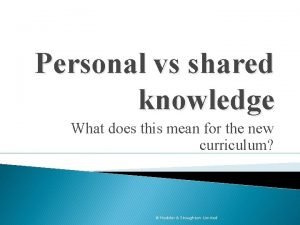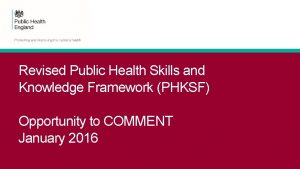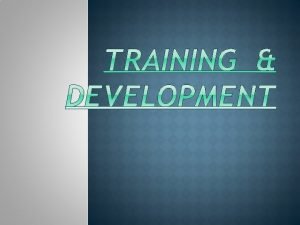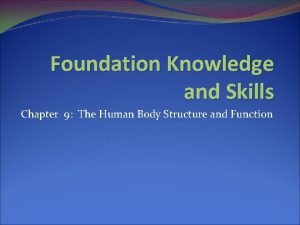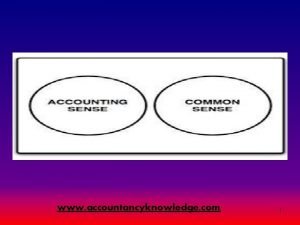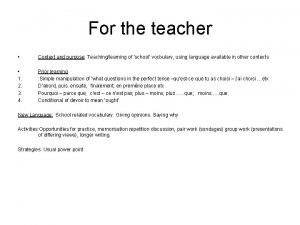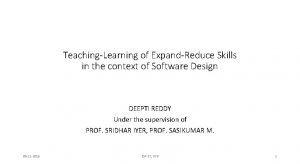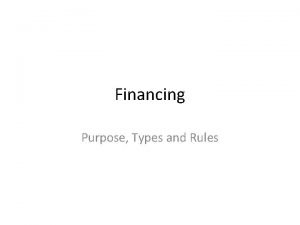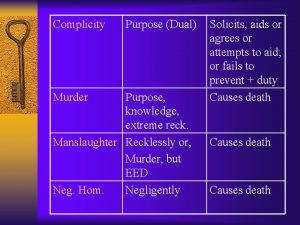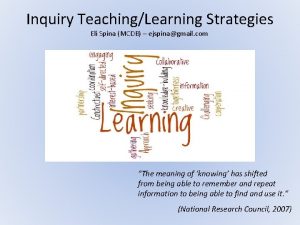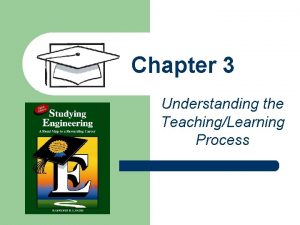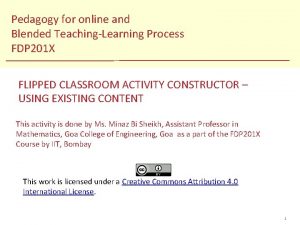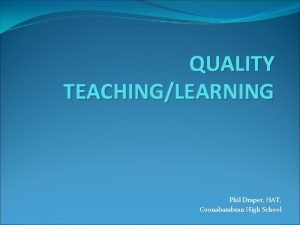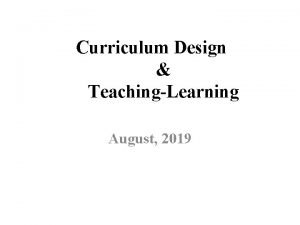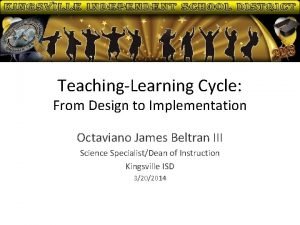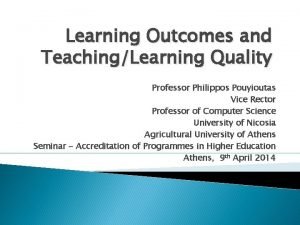What is the purpose of TeachingLearning Knowledge Skills







































































- Slides: 71


What is the purpose of Teaching-Learning? Knowledge & Skills Competent health care professionals Change of attitude & behavior

Bedside teaching is the best “ Medicine is learnt best at bedside not in the classroom” “Best teaching is that taught by the patient himself. ” Sir William Osler (1849 -1919)

Why Bedside Teaching is better? Because, v Up to 56% of diagnosis is based on history v Up to 73% after history + Physical exam v Labs / imaging / etc. adds 20 -25% only Educational Perspectives : Bedside Teaching: Rediscovering a Lost Art Elizabeth G. Doherty and Dara Brodsky, 2012; 13; e 271 Neoreviews

However, there is a drastic Decline (Demise? ) of Bedside Teaching 40 years ago, BST comprised 75% of teaching time By 1998, BST had decreased to 16% only In 2015… ? ? ? ? Much of the education is now TECHNOLOGY based and this trend compromised the clinical exam skills of young physicians ‘THE LOST ART’

Bedside Teaching How to Plan & Organize ? Professor Md. Abid Hossain Mollah Professor of Paediatrics, Dhaka Medical College Med Education Workshop, OGSB: 17 May 2015

Objectives of the presentation At the end of the session the participants will be able to • Define bedside teaching, it’s components & spectrum • Organize & conduct clinical teaching efficiently • Understand what to do & what not to do at b s t • Recognize the common pitfalls of bedside teaching

What is Bed Side Teaching ?

Bedside Teaching? Hippocrates (460 -370 B. C. ) • Patient-centered • Goal directed • Tripartite educational interaction between

Bedside Teaching Patient BST Teacher Students The learning triad

Bedside Teaching Helps transition of Classroom students Hospital/Outdoor ……. . It enhances competencies on--

Bedside Teaching: Spectrum • Clinical skills • Clinical reasoning • Communication skills • Practical procedures • Planning investigations & Treatment • Data interpretation & Retrieval • Professional skills/Transferable skills • Attitudes & Ethics

How to Plan a bed side session?

Planning Bedside Teaching What to do before session How to conduct session at bedside Feedback

Bedside Teaching Planning… Setting OBJECTIVES of the session based on the learners needs

Example Before Bedside teaching A 12 -year-old boy who had history of migratory arthritis 5 years back and now presented with palpitation & effort intolerance Task: Write learning objectives on precordial examination

Objectives At the end of the session students will be able to greet, introduce and reassure the patient Observe the details of precordium Locate & measure the position of the apex beat Distinguish the different types of apex beat Locate & Characterize P 2 Demonstrate & interpret left parasternal heave Demonstrate thrill Auscultate heart sounds at different cardiac areas Identify cardiac murmurs following different maneuvers

Example Topic: Ante-natal check up; how to assess lie, presentation, position and wellbeing of foetus Patient: A 32 weeks pregnant lady Students: Final year MBBS Task: Write OBJECTIVES of this session

Learning Objectives At the end of the session, the students will be able to a) greet and reassure the mother properly b) expose the abdomen adequately seeking permission and maintaining privacy c) inspect the size & shape of abdomen, linea nigra, striae gravidarum, any scar mark, engorged vein d) measure the symphysio-fundal height e) palpate the fundal and pelvic grip to identify presentation of the foetus f) palpate the lateral grip to assess the position of the foetus g) locate, count & interpret the foetal heart sounds

Assessment instruments OSCE station Instruction to the student: a) Please examine the abdomen of this 32 weeks pregnant mother to assess the lie, presentation, position and wellbeing of the foetus b) Give running commentary while examining the lady

Instructions to the Teacher Checklist a) Please write ID number on the top of the sheet b) Please mark the student using the checklist while do the clinical examination Checklist a) Proper greeting, introduction and reassurance (0. 5 x 3) 1. 5 b) Adequate exposure of abdomen, seeking permission (1 x 2) 2 c) Maintain privacy 0. 5 d) Mention size& shape, striae, linea, scar, engorged vein while inspecting abdomen 0. 2 x 5)=1 e) Palpated fundal grip 1 f) Palpated pelvic grip 1 g) Palpated lateral grip 1 h) Auscultate foetal heart sounds at proper site, counted and interpreted (0. 5 x 3) 1. 5 i) Overall clinical examination technique 0. 5 Total = 10

Bedside Teaching Planning… • Preparing teaching area; Physical environment (e. g. light, fan, noise, crowding, curtain etc. ) • Identify relevant persons to assist the session

Planning… Bedside Teaching • Selecting & Preparing patients with clinical findings, simulated patients

Planning Ø Preparing students • Orient students about the session objectives • Brain storming for relevant aspect (this activates prior knowledge) • Brief them what to do and what not to do at the bedside

Planning …. . and of course preparation of teacher v Reviewing the relevant aspects of the problem beforehand which is to be discussed at the bed. v Lesson plan

Summary Planning a Bed Side Teaching • Setting session objectives • Teaching area • Resources & Constraints • Preparation of students, patients, teachers • Lesson plan/ Time management • How to evaluate the session?

What are the ground rules? What to emphasize? Teaching strategy What not to do!!!

At Bedside Teaching clinical skills Ø Skill demonstration model Ø Micro skill model Ø SNAPPS Ø EPITOME model (e=enquiry, p=Physical exam, I=Interpretation, T=Technical proc, O=Options of Dx, M=Management, E=Edu of the patient

At Bedside v Greet v Introduce v Explain the purpose of visit to the patient v Assure the patient of not giving any discomfort

At Bedside Ø Ensure non- threatening environment • A relevant story may be told • Life time experience may be shared

At Bedside Ø Careful about…. • Appropriate Positioning • Eye to eye contact

At Bedside Allocate a specific role to each student to encourage active participation of all • Share history taking and examination • Give one student a specific observer roles • Ask one to summarize the key findings • Asking another to suggest D/D etc.

At Bedside Conduct focused teaching to develop specific clinical skill based on objectives • History taking from a patient with pallor OR • Clinical examination relevant to pallor (e. g. anemia, liver, spleen, bleeding spots, lymphadenopathy etc. ) OR • Counseling of patient and parents

At Bedside Teaching clinical skills Ø Skill demonstration model

At Bedside Teaching Skills: Step-I Teacher demonstrate & Describe the action

At Bedside Teaching Skills: step-II Ø Student attempts in front of teacher & other students

At Bedside Teaching Skills: Step-III Ø Constructive feedback by Teacher & Students What did well How to improve!

At Bedside v Teaching Skills: Step-IV Ø Learning by Doing Ø Allow students to practice by themselves

At Bedside Step V: Correct mistakes • Provide individual feedback and tips how to improve

At Bedside Teaching Skills: Step-VI Ø Evaluation by teacher & Summarization Reviewing the whole clinical session Question & Answer Suggestion from students for overall improvement of the session Further direction to students e. g. self practice, further reading Summarization and take home message

Skill demonstration Steps Activities Example 1 Teacher demonstrate Fundal grip 2 Teacher demonstrate & describes action Explain what is happening 3 Student attempt Fundal grip 4 Teacher/Group constructive feedback 5 Practice Good points & how to improve Fundal grip 6 Evaluate & Summarize

Things to emphasize in clinical teaching!

At Bedside Ø Reinforce what the learner did well !! Example: Patient’s financial status “Your sensitivity to the patient’s concern about the cost of hospitalization showed how aware you are of the financial implications of your medical care and you handled it professionally and caringly” Educational Perspectives : Bedside Teaching: Rediscovering a Lost Art Elizabeth G. Doherty and Dara Brodsky, 2012; 13; e 271 Neoreviews

At Bedside Ø Stimulate humane aspect of patient care • How much is the suffering of the patient • How is he/she is coping with the situation • How the disease affects the patient’s day to day activities • How he/she is coming up with the expenses etc.

At Bedside Emphasize Integration of Clinical medicine with Basic science A 50 yrs old patient presented with right sided hemiplegia, dribbling of food & drink through right angle of mouth and aphasia. • Where is the possible site of lesion • Why the patient can’t talk • Why food dribbles through right angle of mouth? Etc……

Example Instruction to the students: The following statements are related to the VII cranial nerve lesions. Please match the statements (clinical expressions) on the left side with those on the right side (sites of lesions). Clinical expression Sites of lesion in a) If patient have features of both VI and VII nerves lesion Nerve to stapedius b) If patient have features of both VIII and VII nerves lesions Facial canal c) If patient is excessive sensitive to sound in one ear Pons d) If patient loses taste over anterior two-third of tongue Internal acoustic meatus

T-Group Discussion T-group discussion on electrolytes deficiency of Severe Diarrhoea patient Subgroup-1 �S. Na= 140 mmol/L, S. K = 2. 5 mmol/L S. Cl =100 mmol/L S HCo 3= 28 mmol/L �Discuss among group members on why this report? Subgroup-2 �S. Na= 120 mmol/L, S. K = 3. 5 mmol/L S. Cl =100 mmol/L S HCo 3= 28 mmol/L �Discuss among group members on why this report?

Emphasize /Teach bedside etiquette • Students should not shout or chatter among themselves

At Bedside Ø Always make positive criticism!! Example: You have done good…… but addition of such and such would have been better Educational Perspectives : Bedside Teaching: Rediscovering a Lost Art Elizabeth G. Doherty and Dara Brodsky, 2012; 13; e 271 Neoreviews

At the end of Bedside session • Ask patient for any questions • Thanks for his/her contribution

Things not to do at bedside !!!

At Bedside Ø Starting session late

At Bedside X Mobile phone

At Bedside X Ø Kneeling on patient’s bed

No Intimidation

Converting clinical teaching as mini lecture

At Bedside ‡Zvgv‡K w`‡q w. KQ zn‡e bv Example: You have done good…… but addition of such and such would have been better Educational Perspectives : Bedside Teaching: Rediscovering a Lost Art Elizabeth G. Doherty and Dara Brodsky, 2012; 13; e 271 Neoreviews

Paying no attention to patient’s privacy and discomfort

At the end of clinical session Reviewing the session Questions & Answers Summarization & Take home message EVALUATION of Students

Steps of Bed site teaching Step 1: Plan the teaching Step 2: Tell the Objectives Step 3: Assess prerequisite learning Step 4: Demonstrate on a simulated patient or volunteer student Step 5 : Allow the learners to practice Step 6: Observe Step 7: Provide Feedback

Mistakes during clinical Teaching Amin & Eng’ 2009 • Misjudgment of the students strength & weakness • Lack of preparation • Teaching of too much content • Lack of purpose in the session • Inflexibility with teaching strategies • Selection of inappropriate teaching strategy

Summary o Clinical teaching revolves around patients, that allows active learning and students learn how concepts learned earlier can be applied o It allows feedback to the students

Summary Planning & Preparation are the cornerstone of effective bedside teaching

Let us rediscover the lost art

At the bed side ‘micro-skill’ model Neher et al’ 1992, Furney’ 2001 Step 1: Get a commitment- ask students to make provisional or D/D Step 2: Probe for supportive evidence-evaluate the student’s knowledge & reasoning Step 3: Teach general rules that can be used in future cases Step 4: Reinforce what the learner did well-give +ve feedback Step 5: Correct mistakes Begum T’ 2013, Educational Perspectives : Bedside Teaching: Rediscovering a Lost Art Elizabeth G. Doherty and Dara Brodsky, 2012; 13; e 271 Neoreviews

SNAPPS Model Presenting the Summary of the case Narrowing down the differential diagnoses Analyzing the differential diagnosis Probing / asking teacher about areas not understood Planning a management schedule Selecting an issue for self directed learning

Planning… Before bedside session Writing session Objectives Use action verb which are measurable e. g. state, explain, differentiate, perform, operate etc. Avoid non-measurable verbs e. g. Know, understand

Objectives At the end of the session students will be able to show cordial greeting, introduction & reassurance. recognize dyspnea, cyanosis, clubbing count pulse rate, rhythm, volume. measure blood pressure assess edema, assess apex beat, left para sternal heave, P 2 qualify heart sounds, added sounds

Objectives contd. . At the end of the session students will be able to do relevant examinations pertaining to heart failure (e. g. edema, JVP, liver size, lungs bases). Pertaining to infective endocarditis (e. g. hands, nails, spleen fundus) Pertaining to rheumatic manifestations ( e. g. joints, subcut nodules, chorea) examine patient gently keeping in mind the patients comfort interpret the clinical data and tell the diagnosis plan relevant investigations

Skill demonstration Steps Activities Example 1 Teacher demonstrate Take a B P 2 Teacher demonstrate & describes action Explain what is happening 3 Student attempt Take B P 4 Teacher/Group constructive feedback 5 Practice Good points & how to improve Take B P 6 Evaluate & Summarize

Attributes of a good clinical Teacher • Encourage active participation • Integrates clinical medicine with basic science • Provide adequate opportunity for practical skills • Provides good role model • teach patient-oriented rather than disease oriented • shows positive attitudes towards teaching
 Shared and personal knowledge
Shared and personal knowledge Knowledge shared is knowledge squared meaning
Knowledge shared is knowledge squared meaning Knowledge shared is knowledge multiplied meaning
Knowledge shared is knowledge multiplied meaning Knowledge creation and knowledge architecture
Knowledge creation and knowledge architecture Contoh shallow knowledge dan deep knowledge
Contoh shallow knowledge dan deep knowledge Posteriori vs priori
Posteriori vs priori Book smarts vs street smarts
Book smarts vs street smarts Knowledge and knower
Knowledge and knower Gertler econ
Gertler econ Ska skills knowledge attitude
Ska skills knowledge attitude Public health skills and knowledge framework
Public health skills and knowledge framework Agenda for change ksf
Agenda for change ksf New knowledge attitudes and skills acquired in ojt
New knowledge attitudes and skills acquired in ojt Knowledge vs skills
Knowledge vs skills Foundation knowledge and skills
Foundation knowledge and skills Foundation knowledge and skills
Foundation knowledge and skills Intra-personal skills
Intra-personal skills Soft skill vs hard skill
Soft skill vs hard skill Skills passport
Skills passport Hát kết hợp bộ gõ cơ thể
Hát kết hợp bộ gõ cơ thể Frameset trong html5
Frameset trong html5 Bổ thể
Bổ thể Tỉ lệ cơ thể trẻ em
Tỉ lệ cơ thể trẻ em Gấu đi như thế nào
Gấu đi như thế nào Tư thế worm breton
Tư thế worm breton Alleluia hat len nguoi oi
Alleluia hat len nguoi oi Các môn thể thao bắt đầu bằng từ đua
Các môn thể thao bắt đầu bằng từ đua Thế nào là hệ số cao nhất
Thế nào là hệ số cao nhất Các châu lục và đại dương trên thế giới
Các châu lục và đại dương trên thế giới Công thức tính thế năng
Công thức tính thế năng Trời xanh đây là của chúng ta thể thơ
Trời xanh đây là của chúng ta thể thơ Mật thư anh em như thể tay chân
Mật thư anh em như thể tay chân Làm thế nào để 102-1=99
Làm thế nào để 102-1=99 Phản ứng thế ankan
Phản ứng thế ankan Các châu lục và đại dương trên thế giới
Các châu lục và đại dương trên thế giới Thơ thất ngôn tứ tuyệt đường luật
Thơ thất ngôn tứ tuyệt đường luật Quá trình desamine hóa có thể tạo ra
Quá trình desamine hóa có thể tạo ra Một số thể thơ truyền thống
Một số thể thơ truyền thống Cái miệng nó xinh thế
Cái miệng nó xinh thế Vẽ hình chiếu vuông góc của vật thể sau
Vẽ hình chiếu vuông góc của vật thể sau Nguyên nhân của sự mỏi cơ sinh 8
Nguyên nhân của sự mỏi cơ sinh 8 đặc điểm cơ thể của người tối cổ
đặc điểm cơ thể của người tối cổ Giọng cùng tên là
Giọng cùng tên là Vẽ hình chiếu đứng bằng cạnh của vật thể
Vẽ hình chiếu đứng bằng cạnh của vật thể Tia chieu sa te
Tia chieu sa te Thẻ vin
Thẻ vin đại từ thay thế
đại từ thay thế điện thế nghỉ
điện thế nghỉ Tư thế ngồi viết
Tư thế ngồi viết Diễn thế sinh thái là
Diễn thế sinh thái là Dot
Dot Số nguyên tố là
Số nguyên tố là Tư thế ngồi viết
Tư thế ngồi viết Lời thề hippocrates
Lời thề hippocrates Thiếu nhi thế giới liên hoan
Thiếu nhi thế giới liên hoan ưu thế lai là gì
ưu thế lai là gì Hươu thường đẻ mỗi lứa mấy con
Hươu thường đẻ mỗi lứa mấy con Sự nuôi và dạy con của hươu
Sự nuôi và dạy con của hươu Hệ hô hấp
Hệ hô hấp Từ ngữ thể hiện lòng nhân hậu
Từ ngữ thể hiện lòng nhân hậu Thế nào là mạng điện lắp đặt kiểu nổi
Thế nào là mạng điện lắp đặt kiểu nổi Purpose purpose
Purpose purpose Chapter 5 selecting a topic and a purpose
Chapter 5 selecting a topic and a purpose Bulletproof zero knowledge
Bulletproof zero knowledge Zeal without knowledge
Zeal without knowledge Accountancyknowledge.com
Accountancyknowledge.com Factual knowledge in position paper
Factual knowledge in position paper Who owns knowledge
Who owns knowledge The word science is simply latin word for knowledge
The word science is simply latin word for knowledge Goto expert
Goto expert Chief knowledge officer responsibilities
Chief knowledge officer responsibilities Matching column for ssc
Matching column for ssc







